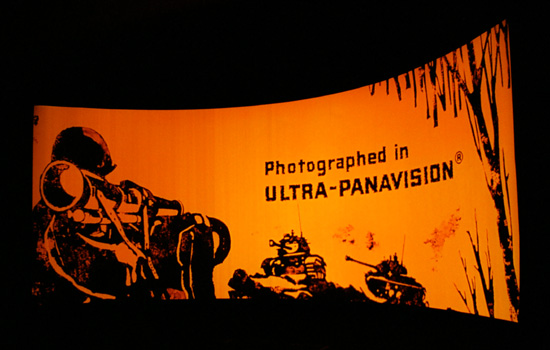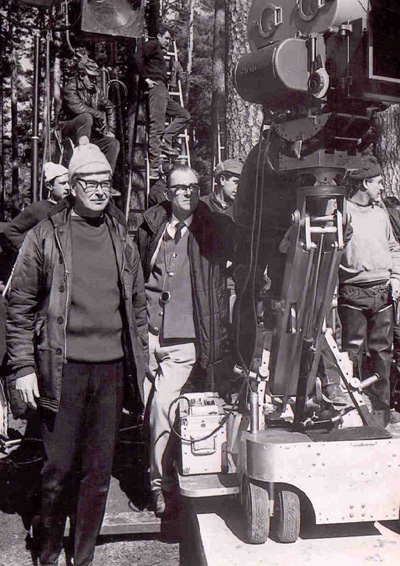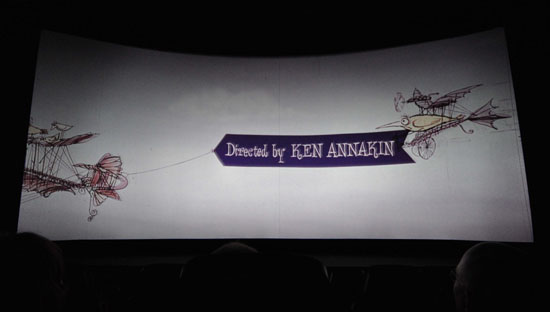Ken Annakin 90th Birthday Salute | Read more at in70mm.com The 70mm Newsletter |
| Recording by: Paul Rayton. Transcribed from audio recording by: Brian Guckian, Ireland. | Date: 21.03.2013 |
 Ken
Annakin in Bradford, March 2000, looking at his own 70mm film on the rewind
bench. Image by Thomas Hauerslev Ken
Annakin in Bradford, March 2000, looking at his own 70mm film on the rewind
bench. Image by Thomas HauerslevDennis Bartok: I’d like to welcome you back to the beautiful restored Lloyd E Rigler Theatre at The Egyptian, for our special 90th Birthday Salute to one of the most esteemed and talented Directors in British Cinema history - Mr. Ken Annakin! [Applause] We are thrilled to have Ken back with us again, here at The Egyptian Theatre; he has been one of our favourite guests over the last few years, for those of you who may have seen him here before, and he’s going to do a short introduction to the movie you are about to see, which is his personal favourite: "Those Magnificent Men in Their Flying Machines", in a beautifully restored 70mm print, courtesy of our great friends at 20th Century Fox [Applause] – and I’d just like thank everybody at Fox, in particular Shawn Belston and Chip Blake for allowing us to screen this beautifully restored print, and also recognise Mr. Scott McQueen, who worked on the restoration of this as well. I’d also just like to briefly thank Don Haber and everybody at BAFTA LA for all of their support, with this event; I’d like to thank Mr. Peter Hampton for putting together a lovely little tribute reel that we’re going to run; I’d also like to thank Pauline Annakin for all of her gracious help in organising this. [Applause] And I believe there I’ve thanked everyone I need to, and now I’d just like to introduce to you, to moderate the Q&A before the film, Mr. Eric Young, DVD producer, long-time friend of Ken Annakin...please join us, Mr. Young! [Applause] Eric Young: Thanks, Dennis...so Ken – you’ve made about 49 movies...and rumour has it you’re actually talking about making another one – is that true? Ken Annakin: That’s true – I would like to make one more: the story of what really happened to Amelia Earhart. EY: And I’m sure many people in the room know how you came about to make "Those Magnificent Men in their Flying Machines", but you have a very interesting history – how did you come about that? KA: Well – I’d made a lot of pictures in England; I started off in documentary of course, but I’ve always loved to entertain people; therefore I got drawn into certain comedies, and then of course Jack Davis, who was the comedy writer who was my partner, we decided that we’d like to make a picture about something important, and that we’d chose the early days of flying...and we got a lot of research done, about all the funny things that had happened, and in this picture actually, most of the comedy – the things really did happen – they weren’t manufactured by us. And it was a long story as to how we actually succeeded in setting up the picture. I thought I was just going to make in my life realistic comedies – comedies based on realism, shall we say, and entertaining people. |
More in 70mm reading: Ken Annakin. Director in Todd-AO and Ultra Panavision 70. "So you Wanna be a Director" Todd-AO "Mag Men" 2CD Released A Magnificent Todd-AO Day in Sweden Internet link: |
 "I
could only achieve it on a system like Ultra Panavision 70", Ken Annakin, March 2000. "I
could only achieve it on a system like Ultra Panavision 70", Ken Annakin, March 2000.And I started off with some Somerset Maugham pictures – "Quartet" and "Trio", and then a number of other comedies – and then Disney came into my life, and I made "Swiss Family Robinson" and three other Disney pictures. Then Daryl Zanuck came into my life with "The Longest Day". And on that picture I was rather lucky in that, as often happens, a Producer – to him, it’s probably very important to get his girlfriend into the picture [Laughter] – and that happened on "The Longest Day", with Irina Demick. And when eventually our script of "Flying Machines" arrived by a very tortuous way, into Zanuck’s hand, he said, “Yes, fine – I know exactly how you make pictures” – because I’d worked with him for three months solid on "Longest Day" – “– but I think that you haven’t enough feminine interest in the picture and I want Irina Demick to be in as a sort of gag, in that she will appear maybe six or seven times”. Well now, I’d shot with her in the French Resistance stuff and found her very easy to work with, and it didn’t worry me at all. And in fact thank God it didn’t, because if you see the picture, if it had been without Irina Demick and her strange character that keeps cropping up, it wouldn’t have been as good a picture – just as many things in the picture wouldn’t have been as good if accidents hadn’t happened...somebody was looking after us with this picture – I mean we wrote the main comedic part for Dick Van Dyke: his agent never showed him the script, therefore he never knew about it, and we finished up with – | |
|
EY: – Stuart Whitman – KA: – Stuart, who gave it tremendous, wonderful, Western, American feeling to the picture...and that’s something I was very lucky in, very lucky in the guy who as you know did all the titles – EY: – Ronald Searle – KA: – Yes, Ronald Searle. When you’re watching the picture it opens with all his wonderful drawings – he was with us for eight weeks, just making cartoons of the real people that we had. And then of course we come to Ron Goodwin, who wrote the music – there again it was something which neither Jack Davis nor I had imagined would be the music for the picture, but it set a style, and The Queen has the music played something like at least four times a year in the grounds of Buckingham Palace [Laughter]. So all these sort of things happened, and we get a night like tonight where you’re all honouring me for having done these wonderful things, but without a lot of other people –and in fact one other person who I know is here tonight, and that is Anne Coates, who cut the movie. [Applause] EY: There she is...over there. Now Ken, your movies have a great authentic feel to them; this one, in addition to "The Longest Day" and all of them – can you tell us a little bit as to where that came from? | |
 Ken
Annakin in Spain filming "Battle of the Bulge". Note the 65mm Panavision
camera to the right. Image supplied by Ken Annakin Ken
Annakin in Spain filming "Battle of the Bulge". Note the 65mm Panavision
camera to the right. Image supplied by Ken AnnakinKA: Well, I was supposed to be an Income Tax Inspector when I was growing up – we were in a Depression in England, and that’s where my father put me, to work. Fortunately I backed the Derby at 20 to 1 and got a hundred pounds...and immediately I went and got a ticket to go to New Zealand – the farthest I could get away from England! [Laughter] And for three years I was a bum, shall we say, in New Zealand, Australia and America. It taught me great deal about people, and coping with people, which has been invaluable in one’s life, making pictures. I thought I was going to be a journalist, a writer of a book, maybe, but I finished up one way or another getting my break to go into documentary during the War, and then Sydney Box, who had been looking after me in documentaries – he had a success with The Seventh Veil – said, “Now if you can just prove that you can handle actors as well as real people, I’ll give you a feature”. And we did this, and I made "Holiday Camp", which was the first of the 49. And as I say, I am very humbly thankful for all the people who have helped me in making a career – I know that I learnt the way of handling situations, which is very necessary if you’re going to succeed. But it’s a very, very co-operative business, and as I say I’m very grateful for all the people who’ve come along my way, and helped me. And you’ll see the result of their work very much tonight – because there’s the building of aeroplanes, there’s the flying of aeroplanes, without seeing wires, there’s a whole lot of very, very strange things go on in this picture tonight. EY: Yes, make sure you look at the details in this film, because it is a 70mm print. And there was no CGI; and it’s astonishing what they did – it’s really astonishing. [Applause] Now, we were speaking before the screening here, and I asked you the question, “What was your favourite experience on this film?”, and you had a great answer for that – | |
|
KA: I tried to work that out – you asked me
that when we were talking tonight – and I can’t think of any favourite
moment in the making of this film...every day was a favourite moment,
because one had to conquer certain difficulties, or one had to fly planes –
and they were all a thrill, they were all things that I wanted to do – and
therefore every day, with all the co-operation one had, every day was a
great adventure. And in the end, we had to dig our heels in and carry on
shooting for three weeks after Fox had said that we were finished and that
the money had run out – but I knew that without certain shots, the picture
could never be finished. We did everything we should do, and it was
finished, and I think it’s a picture one can be proud of. EY: It’s a great thrill for I know a lot of people in this room that saw this film – particularly those of you who were children at the time – and it does my heart good to know that it was as much fun for you to make it as it was for all of us to watch it –  Directed
by the great Ken Annakin. Directed
by the great Ken Annakin.KA: Absolutely – EY: Now I have a special greeting for Ken that was sent over from someone else that worked on the picture that couldn’t be here – those of you that haven’t seen the film, I don’t know if there’s many because it’s such a wonderful picture – the main and end title sequences were illustrated by a wonderful man named Ron Searle – and he couldn’t be here, but he sent over this message, which I’ll read to you: “Dear Ken, sorry not to be able to take the Flying Machine and deliver this message in person, but age-wise I’m not too far behind you. However, from here in France on the great day, Monica and I will have the place awash with glasses of exotic champagne, that will be waved in your direction, with the cry, ‘Here’s to the Magnificent Ken – cheers!’” [Applause] KA: Thank you very much. EY: A couple of just quick notes – we’re about to watch a clip reel of some of Ken’s work, which is incredible and varied, and we’d like to thank Peter Hampton who produced it, and Tony Porter who was the editor; and two of the facilities that did it, that helped with the post-production, were Keep Me Posted and Laser Pacific. Now during the screening of "Magnificent Men" the film will be shown as it was shown in its original release, with a very brief Intermission of five minutes, so stay put, stay close by, and that’ll happen about half way through the picture. And again, it’s a great personal honour for me, and a great occasion to have Ken appear on his 90th Birthday to see this wonderful print. [Applause] KA: Thank you. EY: Thank you! [Applause] | |
| Go: back - top - back issues - news index Updated 22-01-25 |
